-
Call Now
1800-102-2727
Seed Germination: Types of Seed Germination, Mechanism of Seed Germination, Factors Affecting Seed Germination, Practice Problems and FAQs
We all have our own favourite fruit. Most of us buy the fruits we love from the market but given the chance and the adequate space, wouldn’t it be nice to grow our own fruit orchard? But how do we do that?
To grow some plants such as grapes we need to plant the stem of the plant, for some other plants like plantain we need the tuber of the plant. Now think about a mango tree. To grow a mango tree we can plant the seed that we normally throw away after eating the delicious mango fruit. This seed can grow into a huge mango tree in a few years. Quite an amazing phenomenon, don’t you think?
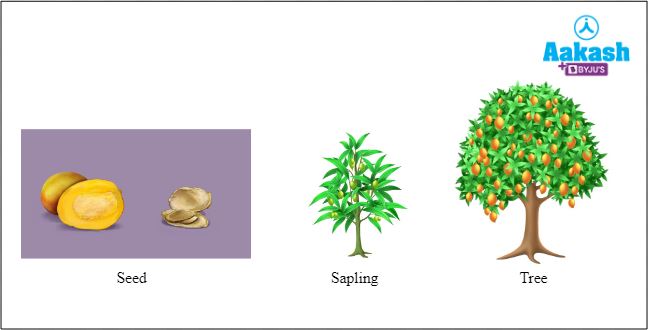
Fig: Mango tree forming from the seed
As an initial step of growing a tree, we have to dig a small pit in the soil and plant the seed inside it. After covering the seed with the soil we will give it some water. If needed, we will also add some manure to the soil to increase its fertility. After some days two little leaves will emerge outside the soil from the seed. What is this process called? This process is called germination. But, all seeds which we plant need not germinate. Do you know why? This is because seeds can germinate only when ideal conditions for germination are available. So we are going to discuss more about seed germination in this article.
Table of contents:
- Seed
- Seed germination
- Types of seed germination
- Mechanism of seed germination
- Factors affecting seed germination
- Vivipary
- Practice Problems
- FAQs
Seed
The fertilised ovule that encloses an embryo is called a seed. It is the connecting link between the parent plant and the progeny. They are the primary means of propagation. They are also adapted to survive under extremely unfavourable conditions.
A mature seed consists of:
- Seed coat - a protective envelope
- Embryo - embryonic plant
- Reserve food and minerals - to provide nourishment
- Enzymes and hormones - for digestion of food and synthesis of new tissues during germination
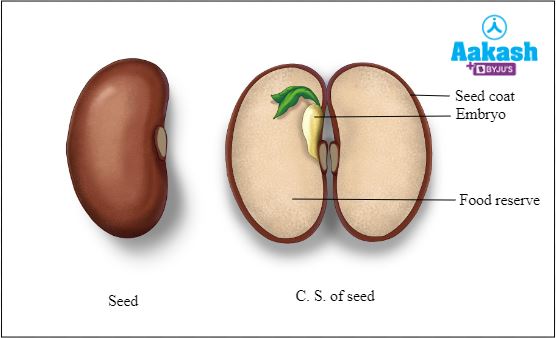
Fig: Seed
Seed germination
The process by which a dormant embryo becomes active, grows out of the seed coat and develops into a seedling is called seed germination. The embryo uses the water from outside and the food stored from the cotyledons or endosperm to grow.

Fig: Seed germination
Seeds of most plants germinate when they are provided with favourable environmental conditions such as:
- Moisture
- Air
- Suitable temperature
- Proper sequence of light and darkness
Changes during seed germination
Following are the changes occurring in a seed during germination:
- The seed coat becomes permeable to H2O, O2 and CO2.
- Seeds coat ruptures, because of the swelling of seed due to imbibition and osmosis.
- Hydration of protoplasm.
- Activation of enzymes.
- Resumption of physiological activities.
- Insoluble materials are broken down into soluble constituents by using enzymes.
- Soluble materials are translocated into growing parts.
- Food is assimilated in the growing organs of plants.
Types of seed germination
Radicle is the first part which comes out during seed germination. It comes out through the micropyle and develops into the root system. This helps the young plant to fix in the soil and to absorb water, nutrients etc. after this the epicotyl and hypocotyl develop and form the shoot system.
According to the order of growth of hypocotyl and epicotyl, there are two types of seed germination and they are as follows:
- Hypogeal germination
- Epigeal germination
Hypogeal germination
The germination of the seeds in which the epicotyl grows first and cotyledons remain underground is called hypogeal germination. The radicle grows deep into the soil and a root system is formed. Then the epicotyl elongates and forms an arch called epicotyl bent. This pushes the plumule upwards out of the soil. Plumule grows fast leaving the cotyledons in the soil. Cotyledons never become green and gradually they dry out and fall.
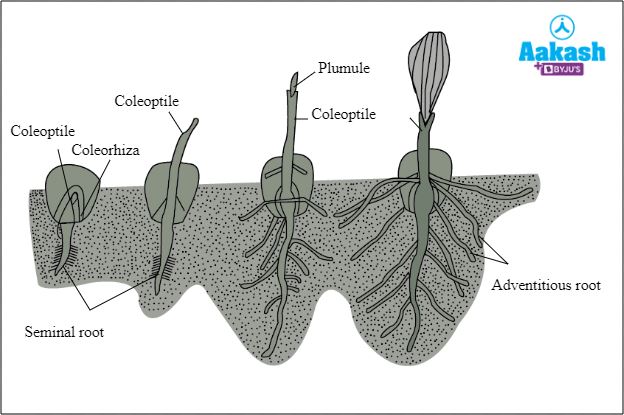
Fig: Hypogeal germination
Hypogeal germination is common in monocotyledons like rice, wheat, maize, palms etc. Some dicots like bengal gram, black gram, pea, mango etc also show this kind of germination.

Fig: Plants which show hypogeal germination
Epigeal germination
The germination of the seeds in which the hypocotyl grows first, pushing up the cotyledons to the soil surface is called epigeal germination. Here the hypocotyl elongates rapidly and pushes the cotyledons upwards above the soil. These cotyledons act as the first leaves of the plant. In most cases cotyledons become green, flat and leaf like. The green cotyledons can make food for a while. The growing stem utilises this food. This will finally dry up and fall off and seedling becomes an independent plant.
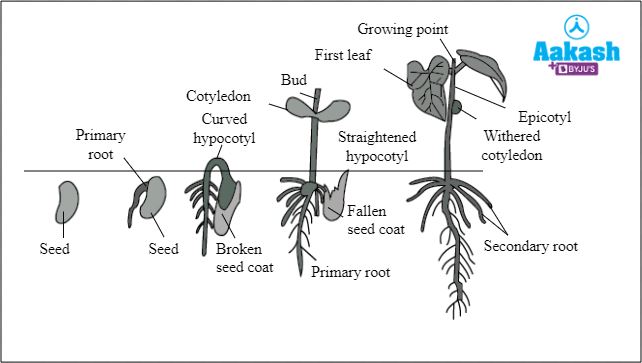
Fig: Epigeal germination
Dicot plants like castor, cotton, tamarind etc. show epigeal germination. It can also be observed in a few monocots like onions.

Fig: Plants which show epigeal germination
Mechanism of seed germination
There are four major steps involved in seed germination, where the dormant embryo in the seed resumes the metabolic activities and grows into a seedling. The steps are as follows:
- Water imbibition
- Resumption of suspended metabolism
- Mobilisation of reserve food
- Breaking of seed dormancy
Water imbibition
The imbibition of water by the dehydrated seed is the first step of germination. Imbibition is a special type of diffusion where the liquid is absorbed by a solid and results in the increase in the volume of the solid.
Micropyle and hilum are the way for the water to enter inside. This results in the rehydration and swelling of seeds. As a result the seed coat ruptures and a radicle emerges from the seed.
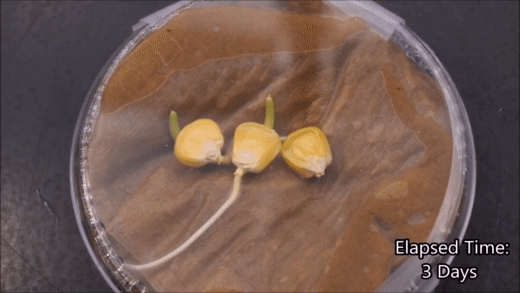
GIF: Imbibition in seeds
Resumption of suspended metabolism
The enzymes inside the seed are reactivated due to re-hydration. This results in the activation or resumption of metabolic activities. Initially the oxygen is not available for the seeds to perform metabolism, hence the activities occur anaerobically. But later, oxygen enters the germinating seed and mitochondria becomes functional and the seed becomes aerobic.
Mobilisation of reserve food
The food stored in the endosperm or cotyledons are utilised for the resumption of metabolic activities. The stored foods are starch, proteins, lipids etc. These food materials are digested to simple sugars initially and then translocated to the embryo.
Hydrolytic enzymes such as amylases, proteases and lipases are produced inside the storage tissues for digesting the stored food.
Breaking of seed dormancy
Seed dormancy can be broken through scarification. It is the process of softening, weakening or breaking the seed coat. The action of germination inhibiting agents can be removed through the following agents:
- Light
- Low temperature
- Chilling
- Running water
Artificial treatments with oxygen, nitrates, gibberellin, ethylene, cytokinin etc. can also break the dormancy.
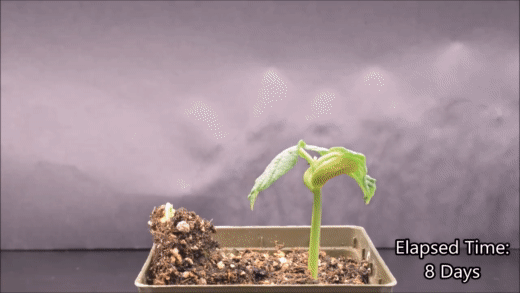
GIF: Germination of seeds in dicotyledons
Role of light in seed germination
Light plays an important role in the seed germination and breaking the dormancy. Some seeds can germinate only in the presence of light; eg: tobacco and lettuce. Such seeds are called light sensitive seeds.
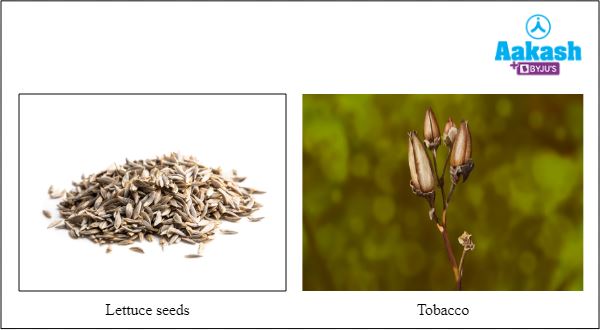
Fig: Light sensitive seeds
Red light is usually responsible for breaking the dormancy and stimulates the germination. But far red light inhibits germination and prolongs seed dormancy. A regulatory pigment called phytochrome is responsible for the sensitivity of the germinating seeds towards red light and far red light.
Factors affecting seed germination
The major factors that affect the seed germination are as follows:
- Water
- Oxygen
- Favourable temperature
- Light
- Nature of the seed coat
- Germination inhibiting substances
Water
An essential factor for seed germination is water. It helps in the hydrolysis and transport of stored food. The other functions of water are as follows:
- Re-activates enzymes
- Provides medium for metabolic reactions
- Softens the seed coat and increases the permeability
Oxygen
For yielding energy by aerobic respiration, seeds need oxygen. Even though water is essential for germination, they can not germinate in water logged soil as in water logged soil the availability of oxygen is less.
Favourable temperature
Moderate temperature is needed for the seeds to germinate. 25℃ to 35℃ is the optimum temperature for the germination of seeds of most tropical plants. For temperate plants it is 10℃ to 25℃. The temperature above or below the optimum temperature will inactivate or destroy the enzymes and affect the germination of plants.
Light
Only some seeds are light sensitive, hence light is not an essential requirement for seed germination.
There are two types of seeds on the basis of their germination in light and dark. They are as follows:
- Negative photoblastic seeds
- Positive photoblastic seeds
Negative photoblastic seeds
The seeds that germinate only in darkness are called negative photoblastic seeds. They will not germinate in the presence of light. Eg: onion, lily.
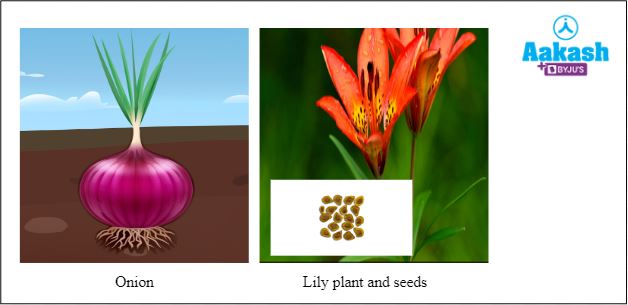
Fig: Negative photoblastic seeds
Positive photoblastic seeds
The seeds that germinate only in the presence of light are called positive photoblastic seeds. They will not germinate in the absence of light. Eg: lettuce seeds, tobacco.
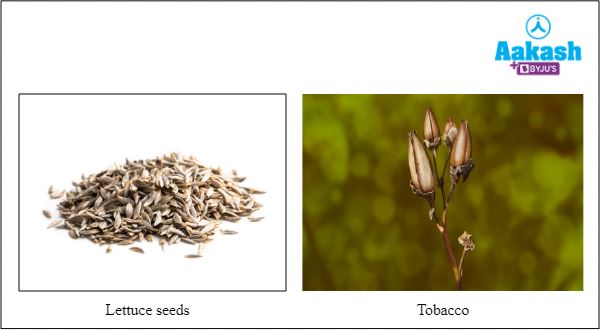
Fig: Positive photoblastic seeds
Nature of the seed coat
Thick, hard and impermeable seed coats inhibit germination, because they are impermeable to water and oxygen. Germination happens when the seed coat is soft, weak and broken.

Fig: Seed coat
Germination inhibiting substances
Some of the substance that inhibit the germination of seeds are as follows:
- Coumarins
- Hydrogen cyanide
- Phenolic acids
- Parasorbic acid
- Industrial wastes
- Soil pollutants
Vivipary
The phenomenon of in situ seed germination by which the germination of seeds occurs inside the unshed fruits is called vivipary. So viviparous plants shed seedlings, and not seeds. Viviparous condition can be observed in some halophytic mangrove plants (eg: Rhizophora). These plants are seen in marshy lands and sea coasts.

Fig: Vivipary in Rhizophora
The seeds inside the fruits germinate while still attached to the parent plant and the seeds are nourished by the parent plant. The embryo grows out of both the seed and the fruit. The embryo projects in the form of a green seedling displaying radicle and hypocotyl. When the hypocotyl grows and increases its weight the seedling separates from the parent plant. After falling on the mud or water, the lateral roots are developed. The plumule emerges and the seedling gets fixed in the soil. Vivipary is an adaptation to prevent the seeds from being carried away by tides and waves.
Practice Problems
1. In hypogeal germination
- the epicotyl elongates faster and the cotyledons remain under the ground.
- the epicotyl elongates faster and the cotyledons emerge out of the ground.
- the hypocotyl elongates faster and the cotyledons remain under the ground.
- the hypocotyl elongates faster and the cotyledons emerge out of the ground.
Solution: The germination of the seeds in which the epicotyl grows first and cotyledons remain underground is called hypogeal germination.
The germination of the seeds in which the hypocotyl grows first, pushing up the cotyledons to the soil surface is called epigeal germination. Hence the correct option is a.
2. Which of the following groups of plants shows hypogeal germination?
- Bengal gram, black gram, castor
- Bengal gram, pea, mango
- Castor, cotton, tamarind
- Pea, mango, onions
Solution: The germination of the seeds by which the epicotyl emerges first and cotyledons remain underground are called hypogeal germination. Hypogeal germination is common in most monocotyledonous plants like rice, wheat, maize, palms etc. Some dicots like bengal gram, black gram, pea, mango etc also show this kind of germination. Dicot plants like castor, cotton, tamarind etc. show epigeal germination. It can also be observed in a few monocots like onions. Hence the correct option is b.
3. Assertion: Seeds can not germinate in water logged soil.
Reason: In water logged soil the availability of oxygen is less.
Find out the correct option for the given assertion and reason.
- Both assertion and reason are true and reason is the correct explanation of assertion.
- Both assertion and reason are true and reason is not the correct explanation of assertion.
- The assertion is true and the reason is false.
- Both assertion and reason are false.
Solution: For yielding energy for aerobic oxidation, seeds need oxygen. Even though water is essential for germination, they can not germinate in water logged soil because water logged soil has less availability of oxygen. Hence the correct option is a.
4. Which of the following is wrong about vivipary?
- Observed in some halophytic mangrove plants
- Seeds are nourished by the parent plant
- Germination of seeds occurs outside the unshed fruits
- An adaptation to prevent the seeds from being carried away by tides and waves
Solution: The phenomenon of in situ seed germination by which the germination of seeds occurs inside the unshed fruits is called vivipary. So viviparous plants shed seedlings, and not seeds. Viviparous condition can be observed in some halophytic mangrove plants (eg: Rhizophora). These plants are seen in marshy lands and sea coasts. The seeds inside the fruits germinate while still attached to the parent plant and the seeds are nourished by the parent plant. Vivipary is an adaptation to prevent the seeds from being carried away by tides and waves. Hence the correct option is c.
FAQs
1. Which are the plant hormones that can induce seed germination?
Answer: Gibberellin is the one hormone which breaks the seed dormancy and promotes the seed germination. Several other hormones like brassinosteroids, ethylene and cytokinin are also promoting seed germination. The one hormone which induces and maintains the seed dormancy is abscisic acid or ABA.
2. What is the tetrazolium test?
Answer: Tetrazolium test is used for the evaluation of the viability of seeds. Germination potential of the seed is assessed through this test. Tetrazolium is an indicator dye that is colourless in the oxidised form and pink in reduced form.
3. Which is the oldest viable seed?
Answer: The oldest viable seed was a Judean date palm seed recovered from an excavation site in Israel and it germinated in 2005.
4. What is germination energy?
Answer: The percentage of number of germinated seeds in a given sample within a period of time (7 to 14 days) is called germination energy.



